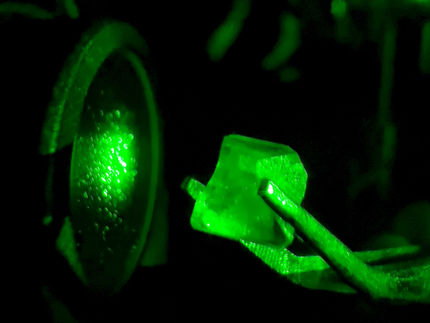Scientists unveil first method for controlling the growth of metal crystals
Researchers have announced the first ever method for controlling the growth of metal-crystals from single atoms. Published in Nature Communications and developed at the University of Warwick, the method, called Nanocrystallometry, allows for the creation of precise components for use in nanotechnology.
Professor Peter Sadler from the University's Department of Chemistry commented that "The breakthrough with Nanocrystallometry is that it actually allows us to observe and directly control the nano-world in motion".
Using a doped-graphene matrix to slow down and then trap atoms of the precious metal osmium the researchers were able to control and quantify the growth of metal-crystals. When the trapped atoms come into contact with further osmium atoms they bind together, eventually growing into 3D metal-crystals.
"Tailoring nanoscopic objects is of enormous importance for the production of the materials of the future", says Dr Barry from the University's Department of Chemistry. "Until now the formation of metal nanocrystals, which are essential to those future materials, could not be controlled with precision at the level of individual atoms, under mild and accessible conditions."
Prof. Sadler says: "Nanocrystallometry's significance is that it has made it possible to grow with precision metal-crystals which can be as small as only 0.00000015cm, or 15 ångström, wide. If a nanodevice requires a million osmium atoms then from 1 gram of osmium we can make about 400 thousand devices for every person on this earth. Compared to existing methods of crystal growth Nanocrystallometry offers a significant improvement in the economic and efficient manufacture of precision nanoscopic objects."
The researchers argue that the new method possesses a range of potential uses. "We envision the use Nanocrystallometry to build precise, atomic-level electronic circuits and new nano-information storage devices. The method also has significant potential for use in the biosensing of drugs, DNA and gases as well for creating unique nano-patterns on surfaces for security labelling and sealing confidential documents. Nanocrystallometry is also an innovative method for producing new metal nano-alloys, and many combinations can be envisaged. They may have very unusual and as yet unexplored properties", commented Dr Barry.
Nanocrystallometry was made possible by state-of-the-art facilities that are only to be found in the UK at the University of Warwick. "The advances in have been made possible thanks to our use of a state-of-the-art aberration-corrected high-resolution transmission electron microscope, the only one microscope of this kind in the UK, that has the potential to image individual atoms in this way. We know that things are made of atoms, but it is really rare to see them dancing in front of your eyes", says Dr Richard Beanland from the University's Department of Physics.
Most read news
Other news from the department science

Get the analytics and lab tech industry in your inbox
From now on, don't miss a thing: Our newsletter for analytics and lab technology brings you up to date every Tuesday. The latest industry news, product highlights and innovations - compact and easy to understand in your inbox. Researched by us so you don't have to.




![[Fe]-hydrogenase catalysis visualized using para-hydrogen-enhanced nuclear magnetic resonance spectroscopy](https://img.chemie.de/Portal/News/675fd46b9b54f_sBuG8s4sS.png?tr=w-712,h-534,cm-extract,x-0,y-16:n-xl)



















































